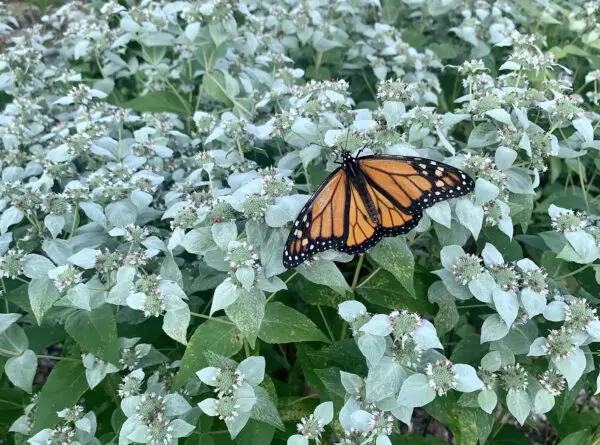Mountain Mint
This plant is a pollinator and butterfly dream. Mountain Mint blooms with tall white-and-green flowers for over a month in the summer. You will see it covered in bees, butterflies, and hummingbirds when in flower. Exceptionally easy to grow and deer tolerant, Mountain Mint is a great companion to other tall native flowers like native coneflowers, Blazing Star, and Black-eyed Susan. Learn how to plant, below.
- Full Sun, Part Sun
- Medium (3-5')
- Summer flowers, Fall flowers
- Pollinator lifeline
What are the benefits of planting Mountain Mint?
Native plants like Mountain Mint have been around in North America for thousands of years. Every drought, blizzard, or weather event they have lived through. They know (and thrive!) in the soil and weather of their home area. All they need is rain to thrive.
Native plants like Mountain Mint are always the most resilient, easy to care for, and beautiful choices for landscaping. They require minimal care (especially compared to lawns!) and can return decades of beauty.
Added bonus: Mountain Mint is deer-proof
Mountain Mint is happily NOT edible to deer. It is similar to other native flowers with strong scents—like Hummingbird Mint, Nodding Onion, and Bee Balm—in that it repels deer away.

How to grow Mountain Mint
Mountain Mint is exceptionally easy to grow since it thrives in a range of sun. Mountain Mint likes full sun to part sun. It can be somewhat drought tolerant but prefers areas with consistent hydration.
Types of native Mountain Mint
There are a few native plants that are called Mountain Mint. Each is slightly different in terms of look (particularly in the flowers) but all types are drought-tolerant, pollinator favorites, and smell like mint when brushed by.

Silverleaf Mountain Mint
Pycnanthemum incanum
Silvery tear-shaped leaves + purple flowers. Perhaps the least ‘showy’ in terms of flowers, it’s still a pollinator favorite and a great color pairing for brighter perennials. 2-6 feet tall.

Narrow-leaved Mountain Mint
Pycnanthemum tenuifolium
Needle-like leaves and white flowers. 2-3 feet tall.

Virginia Mountain Mint
Pycnanthemum virginianum
Similar to Narrow-leaved, with needle-like leaves and white flowers that are sometimes tinged with pink or purple. 2-3 feet tall.
Some other species include:
- Clustered Mountain Mint. (Pycnanthemum municum) Pink flowers. Native to 60% of the United States, from Maine to Florida.
- Whorled Mountain Mint (Pycnanthemum verticillatum), native from Maine to Arkansas.
No matter which one you plant, it’s a pollinator favorite. Here’s a quick overview from NC State Extension that shows a few different kinds, including Narrow-leaved Mountain Mint.
FAQs
Is Mountain Mint aggressive?
Mountain Mint can grow quickly and take over a garden—this is called being ‘aggressive’—if it’s given its preferred rich soil AND it’s allowed to spread unchecked. Here are two ways to keep Mountain Mint in check:
- Pull up the edges of its rhizome roots so they don’t spread. (In my front yard garden, pulling up rhizome roots that spread too far in the spring can take 15 minutes.)
- Grab a shovel and dig up a clump in the spring. Plant this clump elsewhere, or give it away! (I’ve had success halving it every year after its third growing year.)
Aggressive plants are not always “bad.” If you have a large area to cover, picking plants that spread quickly helps fill out an area much faster than slower-growing plants. At the same time, if you have a smaller garden, aggressive plants like Mountain Mint will need spring-time vigilance, especially after their third year.
Where can I find Mountain Mint?
First, the bad news: sourcing a specific native plant can sometimes be a challenge. Sadly, most conventional nurseries stock non-natives or stick to cultivars/nativars.
To make your Mountain Mint sourcing easier, here are four ideas that are tried-and-true for finding native plants:
Where can I find seeds and plants?
Finding native plants can be challenging (we partly blame Marie Antoinette.) To make it easier, we’ve assembled four sourcing ideas.
Native Nursery List
300+ native nurseries makes finding one a breeze
Online Native Plant Sellers
We've included 100+ online resources to help
Society Plant Sales
Every state has a native plant society; find yours
Online Communities
Local Facebook groups are a great plant source
A quick reminder: these can be tall plants
Mountain Mints can get tall—3-6′, depending on the species. Ensure you plant them in the back or middle of your garden, surrounded by shorter plants. Shorter native plants to surround them with include Butterfly Weed (a type of milkweed!), Nodding Onion, and Blue-Eyed Grass.
Native plants to pair with Mountain Mint
These native plants all thrive in the same full sun to part sun as Mountain Mint. Plant them together and enjoy flowers and pollinators throughout the growing season.
To sum it up, Mountain Mint is a great addition to native gardens, thanks to its easy-growing nature and its pollinator magnet abilities. Planting native plants like Mountain Mint allows us to have gorgeous gardens that support wildlife and take minimal effort—especially compared to lawns or non-native gardens. Save yourself time, money, and water and fill your phone with butterfly pictures: plant some Mountain Mint. Happy planting!
Sources
- Johnson, Lorraine and Colla, Sheila. A Northerner’s Guide to Native Plants and Pollinators. (2023), 128-129.
- Lady Bird Johnson Wildflower Center, Hoary Mountain Mint
- Lady Bird Johnson Wildflower Center, Narrowleaf Mountain Mint
- Lady Bird Johnson Wildflower Center, Virginia Mountain Mint





















